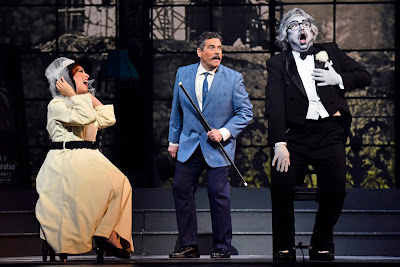Published in Melbourne's Herald Sun 31st May, 2018 (incorrectly under the reviewer's name Catherine Lambert)
More than 20,000 primary school children from across Victoria are in for a marvellous treat as Opera Australia begins its 2018 schools tour. Liesel and Michael Baddorek, who devised the endearing family opera, El Kid, have turned out another gem that opened at Port Melbourne Primary School on Friday.
Taking Edward Lear’s 19th century nonsense nursery rhyme, The Owl and the Pussy-Cat, Liesel and Michael have crafted an enchanting backstory to Pussy and Owl’s journey on a beautiful pea-green boat, aptly titled By the Light of the Moon.
Pussy - aka Agatha - a top-hatted Goth of a cat, is ordered to find a paramour by her reigning, ruthless Queen of Hearts. After a fruitless search on land, Agatha meets Cedric the Owl at the port and pays her way for a search at sea for what becomes a delightful adventure that blends nursery rhyme characters with music arrangements to some of operas most recognisable tunes. As a serenading valorous sailor, Cedric finally wins Agatha’s heart, the mission to find love is accomplished and they set sail again into the nursery rhyme as we know it.
“Row, Row, Row Your Boat” is snugly sung to “La donna è mobile" from Rigoletto. The Queen of Hearts twirls in a bewitched-like trance singing to the tune of Brünnhilde’s “Battle Cry” from Die Walküre and the “Flower Duet” from Lakmé becomes a kooky exchange when Agatha meets quite contrary Mary.
Most importantly, it’s sung with clarity and acted with such conviction by a troupe of enthusiastic and exceptional singers - Kate Amos, Eleanor Blythman, Shakira Tsindos, Nathan Lay, Simon Meadows and Michael Lapina with expert piano accompaniment by Jane Matheson/Pam Christie - that no kid critic could criticise.
The text is awash with clever witticisms that perfectly mirror Lear’s sing-song style. Leisel’s direction is energetic, the story incorporates charming stick puppetry and a punchy palette of colour and imagination comes with Mark Thompson’s easily transportable fairytale-brought-to-life designs.
And on its zany way, wise words that sing of moral muscle over materialism, the beauty to behold in uniqueness and the joyful finale “Ain’t love grand!” bring meaning to this adorable work adults might want to sneak into as well.
By the Light of the Moon
Opera Australia Schools Tour
Until 31st August
4-stars
Production Photos: Jeff Busby
More than 20,000 primary school children from across Victoria are in for a marvellous treat as Opera Australia begins its 2018 schools tour. Liesel and Michael Baddorek, who devised the endearing family opera, El Kid, have turned out another gem that opened at Port Melbourne Primary School on Friday.
 |
| Cast and piano accompanists of Opera Australia's By the Light of the Moon |
Pussy - aka Agatha - a top-hatted Goth of a cat, is ordered to find a paramour by her reigning, ruthless Queen of Hearts. After a fruitless search on land, Agatha meets Cedric the Owl at the port and pays her way for a search at sea for what becomes a delightful adventure that blends nursery rhyme characters with music arrangements to some of operas most recognisable tunes. As a serenading valorous sailor, Cedric finally wins Agatha’s heart, the mission to find love is accomplished and they set sail again into the nursery rhyme as we know it.
“Row, Row, Row Your Boat” is snugly sung to “La donna è mobile" from Rigoletto. The Queen of Hearts twirls in a bewitched-like trance singing to the tune of Brünnhilde’s “Battle Cry” from Die Walküre and the “Flower Duet” from Lakmé becomes a kooky exchange when Agatha meets quite contrary Mary.
Most importantly, it’s sung with clarity and acted with such conviction by a troupe of enthusiastic and exceptional singers - Kate Amos, Eleanor Blythman, Shakira Tsindos, Nathan Lay, Simon Meadows and Michael Lapina with expert piano accompaniment by Jane Matheson/Pam Christie - that no kid critic could criticise.
The text is awash with clever witticisms that perfectly mirror Lear’s sing-song style. Leisel’s direction is energetic, the story incorporates charming stick puppetry and a punchy palette of colour and imagination comes with Mark Thompson’s easily transportable fairytale-brought-to-life designs.
And on its zany way, wise words that sing of moral muscle over materialism, the beauty to behold in uniqueness and the joyful finale “Ain’t love grand!” bring meaning to this adorable work adults might want to sneak into as well.
By the Light of the Moon
Opera Australia Schools Tour
Until 31st August
4-stars
Production Photos: Jeff Busby















